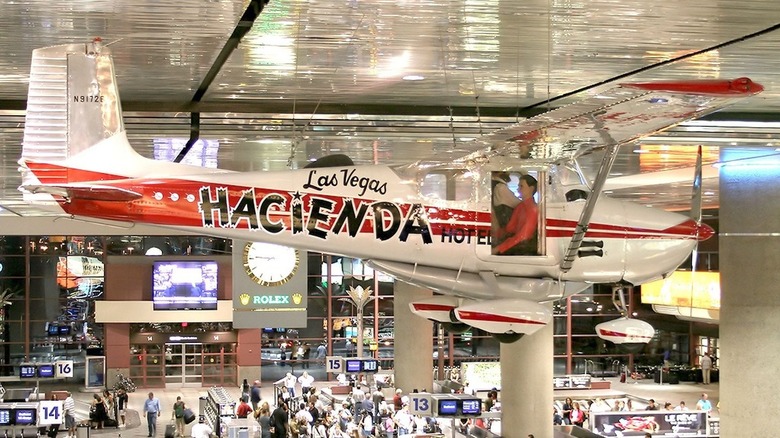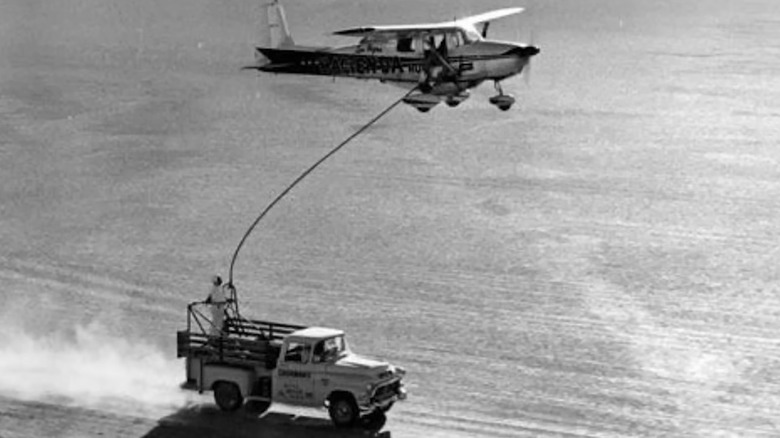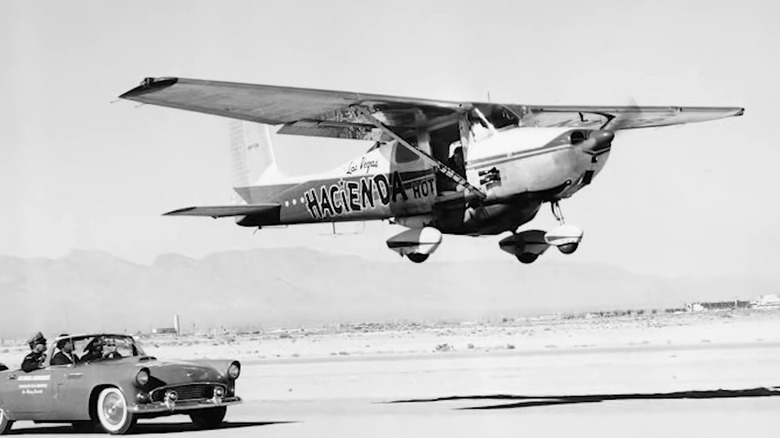Just How Long Was The Longest Flight In History? (And What Kind Of Plane Did They Use?)
In this day and age of high-tech autonomous drones and aircraft, an International Space Station (ISS) that circles the planet every 90 minutes and CEOs that board private rocket ships on the regular, you'd think that the longest sustained airplane flight in history would be a recent accomplishment. And it almost was.
In 2022, an unmanned aerial vehicle (UAV) built by Airbus and flown by the U.S. Army stayed in the air for 64 days, 18 hours and 26 minutes. When the solar-powered Zephyr suddenly crashed to the ground in Arizona, it was only four hours short of establishing a new record for the longest continuous flight that had been set way back in the same year that NASA was created and Elvis Presley entered the Army,
In 1958, two American men climbed aboard a new, modified Cessna 172 at McCarran Airfield in Las Vegas on December 4. They didn't touch back down at that same airfield until February 7, 1959 — a total of 64 days, 22 hours, 19 minutes, and 5 seconds – flying more than 155,000 miles. The circumference of Earth at the equator is 24,901 miles, so it was as if they'd traveled more than six times around the globe. It's been 67 years (and counting) since the record was set, and even if the Zephyr had bested the time, it would've been done by a pilotless drone, not an airplane flown by two living humans.
A publicity stunt for a Vegas hotel
The story of how this historic flight occurred starts a few years earlier. In 1956, one of the very first family-friendly resort/hotel/casinos named the Hacienda opened in Las Vegas. In a publicity stunt suited for a Vegas casino, the owner took the advice of an employee and decided to try breaking the flight endurance record using a plane with the name of the hotel plastered on the sides. The previous record of 47 days had been established almost a decade before, in 1949.
Robert Timm, the employee who made the suggestion, worked as a slot machine repairman for the Hacienda. In a previous life, though, he'd been a World War II fighter pilot, so he had all the qualifications to fly the four-seat, single-engine Cessna 172 (which has since become one of the most iconic planes in aviation history), had a reputation as a dependable, relatively simple plane to fly. Modifications to the aircraft included adding a crude autopilot feature and removing many interior items, like all but the pilot seat, to make way for a bed and a sink so Timm and his co-pilot could clean up.
They also added a 95-gallon belly tank because refueling presented the biggest problem. In fact, the plane had to fly extremely low to the ground twice a day so a hose from a fuel truck driving about 20 feet beneath them could be winched up, attached, and refueling completed. As one might imagine, this was an epic effort unto itself ... and it worked.
A simple Cessna still holds the record
It took Timm four tries to set the record. He encountered mechanical issues during his first three attempts. Meanwhile, another pair of pilots — flying a Cessna 172 — set one record at 50 days in September 1958. Timm's fourth attempt found success with aircraft mechanic John Cook as co-pilot. Since there was no way to constantly track altitude and airspeed back then, they needed to ensure the plane never landed without anyone knowing. So, someone in a moving car just below had to reach up and paint a white stripe onto one of the landing wheels. Scuffed paint would prove the plane had landed before the record was set.
Food was sent up in Thermos flasks. They went to the bathroom on a camping toilet and tossed the waste bags out when they flew over the desert. A quart of bath water was sent up every other day, letting them wash off by standing on an extendable platform attached outside the co-pilot's door. Sleeping was difficult despite the bed, and Timm actually fell asleep on day 36 at the wheel. Thankfully, the autopilot engaged and kept the plane at 4,000 feet for more than an hour.
When Timm and Cook landed on February 7, 1959, they literally had to be lifted out of the plane due to muscle atrophy. Timm died in 1976 and Cook in 1995, but their record-breaking Cessna 172 can still be seen hanging above the baggage carousel at Las Vegas' Harry Reid International Airport.


